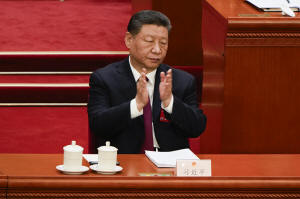China sticks to economic growth target of 'around 5%' despite a looming
trade war
[March 05, 2025] By
SIMINA MISTREANU and KEN MORITSUGU
BEIJING (AP) — The Chinese government unveiled an annual economic growth
target of “around 5%” on Wednesday, despite the possible negative impact
of a looming trade war with the United States, and pledged to address
what it called “inadequate” consumer spending at home.
The target, announced at the opening session of the annual meeting of
China's legislature, is the same as the last two years but will likely
be more difficult to achieve because of higher U.S. tariffs on Chinese
products and other economic headwinds. The use of the modifier “around”
gives the government some wiggle room if growth falls short of the
target.
The level signals the government's intention to try to stabilize growth
in challenging economic times but hold back on more dramatic action that
some economists say is needed to supercharge it.
The government also said in a draft budget released Wednesday that
defense spending would rise 7.2% this year to 1.78 trillion yuan ($245
billion), second only to the United States.
It released the growth target in a separate report, portions of which
were presented to the nearly 3,000 members of the National People's
Congress by Premier Li Qiang in a 55-minute address. The 32-page
document acknowledged both international and domestic challenges.

“An increasingly complex and severe external environment may exert a
greater impact on China in areas such as trade, science, and
technology,” the report said. “Domestically, the foundation for China’s
sustained economic recovery and growth is not strong enough. Effective
demand is weak, and consumption, in particular, is sluggish.”
The IMF has projected China's economy will grow 4.6% this year, down
from 5% in 2024, according to Chinese government statistics.
The annual report placed more emphasis on reviving domestic demand and
consumption than last year's version, echoing a shift by the ruling
Communist Party at meetings in December. It said the government should
“make domestic demand the main engine and anchor of economic growth.”
The question is whether the steps the government takes will be enough to
stabilize the economy and reach its targets for growth, employment and
other economic indicators.
“Achieving this year's targets will not be easy, and we must make
arduous efforts to meet them,” the report said.
It offered some details on the party's plans for a “more proactive
fiscal policy,” including a rise in the government budget deficit from
3% to 4% of GDP, or the size of the overall economy.
Economists expressed doubts over whether the policies will do enough,
noting that the government reduced its inflation target to 2% from 3%
last year, suggesting leaders have accepted that the economy is still
mired in deflation, or a cycle of weakening prices.
[to top of second column] |

Chinese President Xi Jinping applauds during the opening session of
the National People's Congress (NPC) at the Great Hall of the People
in Beijing, China, Wednesday, March 5, 2025. (AP Photo/Ng Han Guan)
 The degree of support is “more
modest than it may appear,” Julian Evans-Pritchard of Capital
Economics said in a report. “We remain skeptical that it will be
sufficient to prevent growth from slowing this year, especially
given the headwinds on the external front and the lack of a more
pronounced shift in government spending toward support for
consumption.”
The government will issue 1.3 trillion yuan ($180 billion) in
ultra-long term bonds, up from 1 trillion yuan last year, the report
said. Of that, 300 billion yuan would go toward a program launched
last year that offers rebates to consumers who trade in automobiles
or appliances for new ones, doubling central government support for
the program.
Across-the-board 20% tariffs imposed on Chinese products by U.S.
President Donald Trump pose the latest threat to an economy already
weighed down by a prolonged real estate slump and sluggish consumer
spending and private business investment. The tariffs could crimp
sales to one of China’s major export markets, making the need to
boost domestic demand more urgent.
At the same time, Chinese leader Xi Jinping wants to wean the
economy off its long-running dependence on the highly indebted real
estate market.
He is directing economic resources into developing a more
innovative, high-tech economy — and with growing restrictions on
U.S. technology exports to China, one that isn't beholden to other
countries for the most powerful semiconductors and other electronic
components.
That has remained an overarching long-term economic goal of the
Communist Party, though it has enacted various measures since
September that suggest a shift in emphasis toward shoring up growth
in the short-term.
“A target of around 5% is well aligned with our mid- and long-term
development goals and underscores our resolve to meet difficulties
head-on and strive hard to deliver,” Li said, reading from the
government report.
The report highlighted artificial intelligence in a section on
fostering “industries of the future,” saying the government would
support the application of large-scale AI models, smart
manufacturing equipment, connected vehicles and intelligent robots.
It also reiterated the party's announcement in December that the
central bank would shift its monetary policy from “prudent” to
“moderately loose" for the first time in more than a decade.
All contents © copyright 2025 Associated Press. All rights reserved
 |